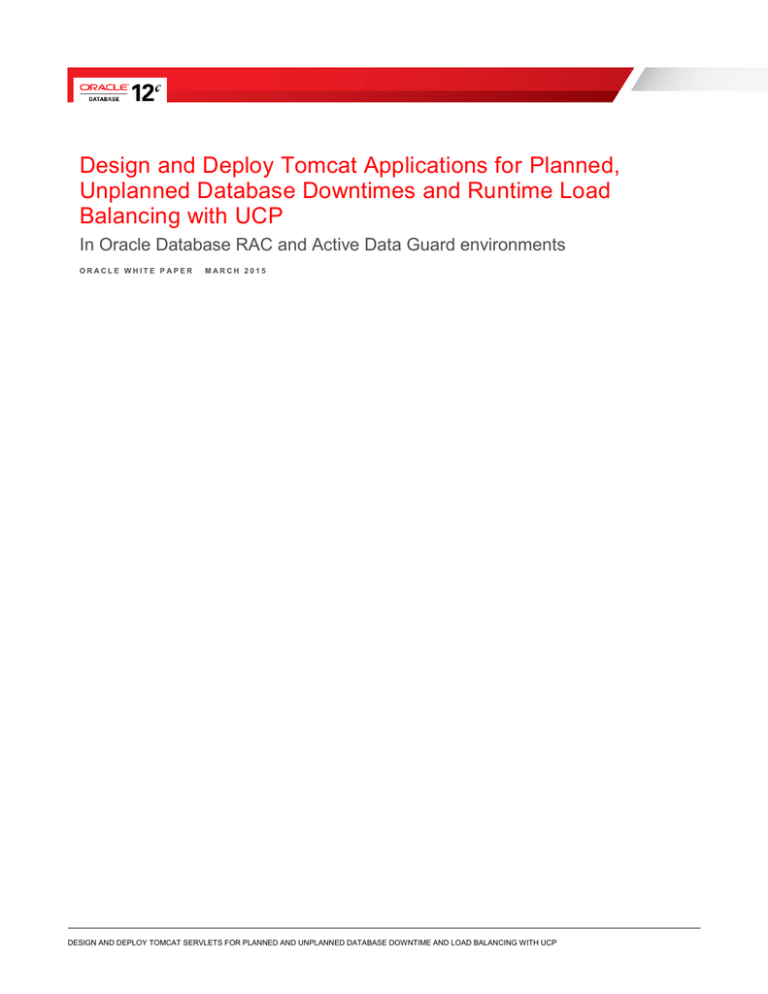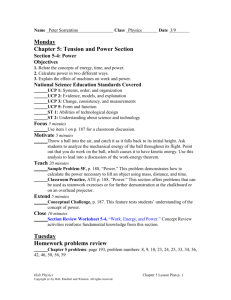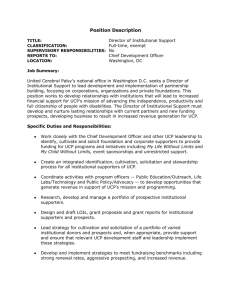
Design and Deploy Tomcat Applications for Planned,
Unplanned Database Downtimes and Runtime Load
Balancing with UCP
In Oracle Database RAC and Active Data Guard environments
ORACLE WHITE PAPER
MARCH 2015
DESIGN AND DEPLOY TOMCAT SERVLETS FOR PLANNED AND UNPLANNED DATABASE DOWNTIME AND LOAD BALANCING WITH UCP
Table of Contents
Introduction
3
Issues to be addressed
3
Oracle Database 12c High-Availability and Load Balancing Concepts
4
Configure Tomcat for UCP
4
Create a New Database Resource
4
Create a JNDI lookup in the servlet
5
Create a web.xml for the servlet
6
Hiding Planned Maintenance from Tomcat Servlets
6
Web Applications Steps
6
DBA or RDBMS Steps
7
Hiding Unplanned Database downtime from Tomcat Servlets
9
Developer or Web Application Steps
9
DBA or RDBMS Steps
9
Runtime Load Balancing (RLB) with Tomcat Servlets
Web Application steps
Appendix
Enable JDBC & UCP logging for debugging
Conclusion
DESIGN AND DEPLOY TOMCAT SERVLETS FOR PLANNED AND UNPLANNED DATABASE DOWNTIME AND LOAD BALANCING WITH UCP
10
10
11
11
12
Introduction
Achieving maximum application uptime without interruptions is a critical business requirement. There are a number of
requirements such as outage detection, transparent planned maintenance, and work load balancing that influence
application availability and performance. The purpose of this paper is to help Java Web applications deployed with
Apache Tomcat, achieve maximum availability and scalability when using Oracle.
Are you looking for best practices to hide your tomcat applications from database outages? Are you looking at, smooth &
stress-free maintenances of your tomcat applications? Are you looking at leveraging Oracle Database’s runtime load
balancing in your tomcat web applications? This paper covers the configuration of your database and Tomcat Servlets for
resiliency to planned maintenance, unplanned database outages and dynamic balancing of the workload across database
instances, using RAC, ADG, GDS1, and UCP.
Issues to be addressed
The key issues that impede continuous application availability and performance are:
» Planned Maintenance:
» Achieve transparent maintenance: Make the maintenance process fast and transparent to applications for
continuous availability.
» Session Draining: When the targeted instance is brought down for maintenance, ensure that all work
completes. We will describe how to drain sessions without impacting in-flight work and also avoid logon storms
on active instance(s) during the planned maintenance.
» Unplanned Downtimes:
» Outage detection: Web application’s timeouts are unpredictable and unreliable. This paper describes how to
configure WebSphere Servlets to be notified of outages as fast as possible.
» Error handling: Several types of SQL exceptions may be received by your Servlets; how to determine that such
errors are indicative of database service failure?
» Recovery with Response Time Targets: Upon outage the Oracle Database RAC system needs a short period
of time to recover before becoming fully operational again. How to react quickly and keep such “brownout” period
under SLA targets?
» Outcome of in-flight work: Have you ever paid twice for books, flights or taxes? Making a reliable determination
of the outcome of the in-flight transaction in the face of database outages was a challenge until Oracle Database
12c. We will describe, how to design Servlets and configure Oracle Database 12c for solving this challenge.
» Continuation of in-flight work: How to design Servlets and configure Oracle Database 12c and UCP to allow
safe and transparent replay of in-flight transactions in the event of unplanned database outages.
» Workload Balancing: In RAC, RAC ONE and ADG environments, connection requests are by default distributed
randomly by the Net Listener. How to configure your web applications and configure the database for optimal
distribution of the workload when the node/services are added/removed?
1 http://www.oracle.com/technetwork/database/availability/maa-consolidation-2186395.pdf
DESIGN AND DEPLOY TOMCAT SERVLETS FOR PLANNED AND UNPLANNED DATABASE DOWNTIME AND LOAD BALANCING WITH UCP
If you are a Java developer or architect looking to exploit Oracle Database Real Application Cluster (RAC), Exadata,
Active Data Guard (ADG), Global Data Services (GDS) and Oracle Universal Connection Pool (UCP) solutions for
planned and unplanned database downtime and workload balancing, this is the paper for you. If you are a DBA looking for
database configuration steps to meet Web apps high-availability and load balancing requirements, this is the paper for
you too.
Oracle Database 12c High-Availability and Load Balancing Concepts
To support high-availability and load balancing solutions, Oracle Database 12c and prior releases furnish HA configurations
(RAC, Data Guard) and features which are leveraged by Oracle Database drivers (e.g., Oracle JDBC) and connection pools
(e.g., UCP). This paper will refer to the following features, mechanisms, and concepts described in Java Programming
with Oracle Database 12c RAC and Active Data Guard 2 white paper:
» Universal Connection Pool (UCP)
» Fast Application Notification (FAN)
» Oracle Notification Service (ONS)
» Fast Connection Failover (FCF)
» Logical Transaction ID (LTXID)
» Database Request
» Recoverable Errors
» Mutable Functions
» Transaction Guard (TG)
» Application Continuity (AC)
Configure Tomcat for UCP
Universal Connection Pool (UCP) has the built in support for planned maintenance, unplanned downtimes and runtime load
balancing. UCP along with RAC, RAC One and ADG is a tested and certified combination for handling database failovers.
UCP has been successfully used by many customers to handle failovers seamlessly. Configuring UCP in Apache Tomcat is
explained in detail, hereafter.
Deploying a servlet which accesses Oracle Database through Oracle JDBC driver and Oracle Universal Connection Pool
(UCP) in a Tomcat application container requires the following steps:
» Create a New Database Resource
» Create a JNDI lookup in the servlet
» Create a web.xml for the Servlet
Create a New Database Resource
First ensure that Oracle JDBC jar, ojdbc7.jar, ucp.jar and ons.jar are present in $CATALINA_HOME/lib. Make sure that all
three jar files are from the same database version. UCP is configured either as a global resource in server.xml for all
applications, or as an application specific resource in context.xml
($CATALINA_HOME/webapps/<APPLICATION_NAME>/META-INF/context.xml) as shown in Fig 1a below.
2 http://www-content.oracle.com/technetwork/database/application-development/12c-ha-concepts-2408080.pdf
DESIGN AND DEPLOY TOMCAT SERVLETS FOR PLANNED AND UNPLANNED DATABASE DOWNTIME AND LOAD BALANCING WITH UCP
Note that all required UCP properties such as minPoolSize, maxPoolSize, fastConnectionFailoverEnabled,
ONSConfiguration etc., are mentioned while creating a new database resource.
Fig 1a: New Database Resource in Tomcat
<Context docBase="UCPTomcat" path="/UCPTomcat" reloadable="true"
source="org.eclipse.jst.jee.server:UCPTomcat">
<Resource
name="tomcat/UCPPool"
auth="Container"
<!-- Defines UCP or JDBC factory for connections -->
factory="oracle.ucp.jdbc.PoolDataSourceImpl"
<!-- Defines type of the datasource instance -->
type="oracle.ucp.jdbc.PoolDataSource"
description="UCP Pool in Tomcat"
<!-- Defines the Connection Factory to get the physical connections -->
connectionFactoryClassName="oracle.jdbc.pool.OracleDataSource”
minPoolSize="2"
maxPoolSize="60"
initialPoolSize="15"
autoCommit="false"
user="scott"
password="tiger"
<!-- UCP property for receiving FAN events
-->
fastConnectionFailoverEnabled="true"
<!-- Database URL -->
url="jdbc:oracle:thin:@(DESCRIPTION=(ADDRESS_LIST=(ADDRESS=(PROTOCOL=tcp)(HOST=proddbclust
er-scan)(PORT=1521)))(CONNECT_DATA=(SERVICE_NAME=proddb)))"
<!— onsConfiguration not required with auto-ONS in 12c
onsConfiguration="nodes=<RAC_node1>:<port1>, <RAC_node2>:<port2>, <RAC_node3>:<port3>"
-->
</Resource>
</Context>
Create a JNDI lookup in the servlet
The following code snippet shows how to get a database connection by referring to the JNDI datasource created in Tomcat.
Context ctx = new InitialContext ();
Context envContext = (Context) ctx.lookup("java:/comp/env");
// Look up a data source
javax.sql.DataSource ds=
(javax.sql.DataSource) envContext.lookup ("tomcat/UCPPool");
PoolDataSource pds= (PoolDataSource)ds;
DESIGN AND DEPLOY TOMCAT SERVLETS FOR PLANNED AND UNPLANNED DATABASE DOWNTIME AND LOAD BALANCING WITH UCP
Connection conn = pds.getConnection();
Create a web.xml for the servlet
The data source resource reference should also be present in web.xml as illustrated hereafter.
<?xml version="1.0" encoding="UTF-8"?>
<web-app xmlns:xsi="http://www.w3.org/2001/XMLSchema-instance"
xmlns="http://java.sun.com/xml/ns/javaee"
xmlns:web="http://java.sun.com/xml/ns/javaee/web-app_2_5.xsd"
xsi:schemaLocation="http://java.sun.com/xml/ns/javaee
http://java.sun.com/xml/ns/javaee/web-app_3_0.xsd" version="3.0">
<servlet>
<servlet-name>DemoServlet</servlet-name>
<servlet-class>DemoServlet</servlet-class>
</servlet>
<resource-ref>
<description>UCP datasource to connect to DB</description>
<res-ref-name>tomcat/UCPPool</res-ref-name>
<res-type>javax.sql.DataSource</res-type>
<res-auth>Container</res-auth>
</resource-ref>
</web-app>
Hiding Planned Maintenance from Tomcat Servlets
For maintenance purposes (i.e., software upgrades), the Oracle Database instances can be gracefully shutdown one at a
time without disrupting the operations and availability of web applications. Upon FAN DOWN event3, UCP drains sessions
away from the instance(s) targeted for maintenance. What is the configuration of web applications and the database to
achieve session draining at service stop or relocation? In a nutshell, the procedure consists in stopping non-singleton
services running on the target database instance or relocating singleton ones from the target instance to a new instance.
Web Applications Steps
To hide the planned database maintenance, Web applications need to:
(i) Enable Fast Connection Failover (FCF) as mentioned above. FCF can be enabled either in context.xml (recommended
method) or set programmatically. Refer to Fig 1a. New Database Resource in Tomcat for more details on enabling FCF in
context.xml.
FCF can also be enabled programmatically as shown below.
PoolDataSource pds = new PoolDataSourceFactory.getPoolDataSource();
// not required with auto-ONS in 12c
pds.setONSConfiguration("nodes=<RACNode1>:<port1>,<RACNode2>:<port2>,<RACNode3>:port3");
pds.setFastConnectionFailoverEnabled(true);
(ii) check that ons.jar is in the classpath.
(iii) In addition, with release 12.1.0.2, UCP introduces PlannedDrainingPeriod, a new system property which allows a
graceful draining period. It can be specified as a JDK system property (i.e., using -D) or it can be set as a context
parameter.
-Doracle.ucp.PlannedDrainingPeriod=30
3 status=down reason=user
DESIGN AND DEPLOY TOMCAT SERVLETS FOR PLANNED AND UNPLANNED DATABASE DOWNTIME AND LOAD BALANCING WITH UCP
Setting it as a context parameter
<!—System property for graceful planned maintenance -->
<context-param>
<param-name>oracle.ucp.PlannedDrainingPeriod</param-name>
<param-value>30</param-value>
</context-param>
DBA or RDBMS Steps
DBAs must perform the following steps4 to stop all services on the target machine where the database instance is
scheduled for maintenance. For each service repeat the following actions:
1.
Stop the service without using –force option or relocate the service. Service relocation is required for singleton
service (i.e., runs only on one instance at a time)
$srvctl stop service –db <db_name> -service <service_name> -instance <instance_name
or (NOTE: Omitting –service stops all services)
$srvctl relocate service –db <db_name> -service <service_name> -oldinst <oldins> newinst <newinst>
2.
Disable the service and allow sessions some time to drain. E.g., 2-30 minutes. This avoids the logon storm on the
other active instance where the workload gets transferred. Disabling service is optional if you choose to disable the
instance.
$srvctl disable service –db <db_name> -service <service_name> -instance <instance_name>
3.
Wait to allow sessions to drain Example: 10-30 minutes
4.
Check for long-running sessions and terminate these (you may check again afterwards)
SQL> select count(*) from ( select 1 from v$session where service_name in
upper('<service_name>') union all
select 1 from v$transaction where status = 'ACTIVE' )
SQL> exec dbms_service.disconnect_session (‘<service_name>‘,
DBMS_SERVICE.POST_TRANSACTION);
5.
Repeat steps 1-4 for all services targeted for planned maintenance.
6.
Stop the database instance immediately.
4 See Metalink note 1593712.1 @ https://support.oracle.com/epmos/faces/DocumentDisplay?id=1593712.1 for more details
DESIGN AND DEPLOY TOMCAT SERVLETS FOR PLANNED AND UNPLANNED DATABASE DOWNTIME AND LOAD BALANCING WITH UCP
$srvctl stop instance –db <db_name> -instance <instance_name> -stopoption immediate
7.
Disable instance to prevent restarts during maintenance
$srvctl disable instance –db <db_name> -instance <instance_name>
8.
Apply patch or carry out the scheduled maintenance work
9.
Enable then Start the instance again
$srvctl enable instance –db <db_name> -instance <instance_name>
$srvctl start instance –db <db_name> -instance <instance_name>
10. Enable then start the service back and check if the service is up and running
$srvctl enable service –db <db_name> -service <service_name> -instance <instance_name>
$srvctl start service –db <db_name> -service <service_name> -instance <instance_name>
Figure 1, hereafter shows connections distribution of XYZ service across two RAC instances before and after Planned
Downtime. Notice that the connection workload went from fifty-fifty across both instances to hundred-zero. In other words,
RAC_INST_1 can be taken down for maintenance without any impact on the business operation.
120
RAC_Inst_1
Number of Connections
100
Fig 1: Planned Downtime
RAC_Inst_2
80
60
40
20
0:00
0:03
0:06
0:09
0:12
0:15
0:18
0:21
0:24
0:27
0:30
0:33
0:36
0:39
0:42
0:45
0:48
0:51
0:54
0:57
1:00
1:03
1:06
1:09
1:12
1:15
1:18
1:21
1:24
1:27
1:30
1:33
0
Time (Mins)
DESIGN AND DEPLOY TOMCAT SERVLETS FOR PLANNED AND UNPLANNED DATABASE DOWNTIME AND LOAD BALANCING WITH UCP
Hiding Unplanned Database downtime from Tomcat Servlets
Tomcat Servlets can be configured to handle unplanned database outages using the following features and mechanisms:
» Fast Connection Failover (FCF)
» Transaction Guard (TG)
» Application Continuity (AC)
Please refer to the white paper, Java Programming with Oracle Database 12c RAC and Active Data Guard 5 for
understanding these concepts in detail.
Developer or Web Application Steps
Need to set FCF to true for handling unplanned outages. FCF enables UCP to detect dead instance and helps in
transferring the work load to the surviving active instance as soon as the unplanned down event occurs. Enable
Transaction Guard and Application Continuity to achieve continuous service without any interruption of in-flight work. Please
refer to the white paper Java Programming with Oracle Database 12c RAC and Active Data Guard6 for understanding
how TG and AC will protect your application from unplanned downtimes.
DBA or RDBMS Steps
To simulate Fast Connection Failover, the DBA may either stop the service on one instance with –force option (as specified
hereafter) or, alternatively, kill the Oracle instance SMON background process. An even more drastic approach consists in
powering down of one of the nodes supporting the database.
$srvctl stop service –db <db_name> -service <service_name> -instance <instance_name> force
Figure 2, shows connections distribution of XYZ service across two RAC instances before and after unplanned downtime.
Notice that the connection workload went from fifty-fifty across both instances to hundred-zero. In other words, the
remaining instances sustain the workload without disrupting the business operation.
5 http://www-content.oracle.com/technetwork/database/application-development/12c-ha-concepts-2408080.pdf
6 http://www-content.oracle.com/technetwork/database/application-development/12c-ha-concepts-2408080.pdf
DESIGN AND DEPLOY TOMCAT SERVLETS FOR PLANNED AND UNPLANNED DATABASE DOWNTIME AND LOAD BALANCING WITH UCP
Number of Connections
Fig 2: Unplanned Downtime
120
RAC_Inst_1
100
RAC_Inst_2
80
60
40
20
0:00
0:03
0:07
0:10
0:14
0:17
0:21
0:24
0:28
0:31
0:35
0:38
0:42
0:45
0:49
0:52
0:56
0:59
1:03
1:06
1:10
1:13
1:17
1:20
1:24
1:27
1:31
1:34
0
Time (Mins)
Runtime Load Balancing (RLB) with Tomcat Servlets
Runtime Connection Load Balancing enables routing of work requests across RAC or ADG instances to achieve predictable
runtime performance. RAC and GDS post runtime load balancing advisories every 30 seconds. UCP uses the Load
Balancing advisory to balance the work across RAC instances, dynamically and thereby achieving best scalability. Runtime
Load Balancing comes also into play when new node(s)/instance(s) are added/removed to/from the service; the work load
gets balanced in both situations without any manual intervention.
Web Application steps
Web applications only need to setFastConnectionFailover to true as already described (Refer to Fig 1a: New
Database Resource in Tomcat for more details) to allow receiving FAN Load Balancing advisories. UCP dispenses
connections from the least loaded database instance (in RAC or GDS environments). Ultimately the workload is uniformly
spread across the databases in question (RAC or GDS).
DBA or RDBMS Steps
Configure the Oracle RAC Load Balancing Advisory with the following values.
Set ‘Runtime Load Balancing Goal’ to SERVICE_TIME or THROUGHPUT
$srvctl modify service –db <db_name> -service <service_name> -rlbgoal SERVICE_TIME
$gdsctl modify service –db <db_name> -service <service_name> -rlbgoal SERVICE_TIME
Set ‘Connection Load Balancing Goal’ to SHORT
$srvctl modify service –db <db_name> -service <service_name> -clbgoal SHORT
$gdsctl modify service –db <db_name> -service <service_name> -clbgoal SHORT
DESIGN AND DEPLOY TOMCAT SERVLETS FOR PLANNED AND UNPLANNED DATABASE DOWNTIME AND LOAD BALANCING WITH UCP
Figure 3, shows connections distribution of XYZ service across three RAC instances. Notice that the workload is gradually
distributed across the available instances with 48-51 connections each between RAC_Instance_1 and RAC_Instance_2.
When a new instance, RAC_Instance_3 is added, the load will be re-distributed evenly to 33-33-33. After some time,
RAC_Instance_3 is removed, UCP gradually rebalances the load between the remaining instances and in this case,
achieves 48-51 connection workload distribution.
RAC_Inst_1
RAC_Inst_2
100
RAC_Inst_3
80
60
40
20
0
0:00
0:03
0:07
0:10
0:14
0:17
0:21
0:24
0:28
0:31
0:35
0:38
0:42
0:45
0:49
0:52
0:56
0:59
1:03
1:06
1:10
1:13
1:17
1:20
1:24
1:27
Number of Connections
Fig 3: Run time Load Balancing
Time (Mins)
Appendix
Enable JDBC & UCP logging for debugging
Enable JDBC & UCP logging when there are issues. This helps to debug and find the root cause of the problem. There are
few steps for enabling JDBC & UCP logging.
» Configure debug jar in the classpath
» Enable logging
» Setup a config file for advanced logging
Configure debug jar in the classpath:
Make sure to have the debug jar file ojdbc7_g.jar in the classpath.
Enable logging
In order to get any log output from the Oracle JDBC drivers you must enable logging. Enable logging by setting the
system property -Doracle.jdbc.Trace = TRUE. This turns logging ON. Refer to Fig 5: Enable JDBC/UCP logging in
Tomcat.
Setup a config file for advanced logging
Create a configuration file, for example oracletrace.properties and insert the following and save the file.
Enable the config file by setting the system properties –Djava.util.logging.config.file =<localtion of the config
file>. Refer to Fig 5: Enable JDBC/UCP Logging in Tomcat.
DESIGN AND DEPLOY TOMCAT SERVLETS FOR PLANNED AND UNPLANNED DATABASE DOWNTIME AND LOAD BALANCING WITH UCP
# FOR UCP logs
.level=WARNING
oracle.ucp.jdbc.oracle.level=FINEST
oracle.ucp.jdbc.level=FINEST
oracle.ucp.common.level=FINEST
oracle.ucp.jdbc.oracle.rlb.level=FINEST
# For JDBC Driver logs
level=SEVERE
oracle.jdbc.level=ALL
oracle.jdbc.driver.level=FINEST
oracle.jdbc.pool.level=FINEST
oracle.jdbc.util.level=OFF
oracle.jdbc.handlers=java.util.logging.FileHandler
java.util.logging.FileHandler.level=FINE
java.util.logging.FileHandler.pattern=jdbc.log
java.util.logging.FileHandler.count=1
java.util.logging.FileHandler.formatter=java.util.logging.SimpleFormatter
Fig 5: Enabling JDBC/UCP logging in Tomcat
<!—System property for graceful planned maintenance -->
<context-param>
<param-name>oracle.jdbc.Trace</param-name>
<param-value>true</param-value>
<param-name>java.util.logging.config.file</param-name>
<param-value>/opt/tomcat/logs/oracletrace/oracletrace.properties</param-value>
</context-param>
Conclusion
This paper gives you a comprehensive and practical coverage of Tomcat Web applications with Oracle Database 12c; more
specifically how to design and configure both the RDBMS, UCP and the Tomcat container for resiliency to planned, and
unplanned database downtimes and workload balancing. The steps described in this paper are valid for all Oracle
Database 12c high availability and scalability configurations including RAC, Active Data Guard and Global Data Services.
The complete UCP Tomcat demo referenced in this paper will be posted on https://github.com/oracle/jdbc-ucp. Java
architects, Web application designers and DBAs may now design robust and reliable Tomcat Web applications for better
user experience and operation continuity.
DESIGN AND DEPLOY TOMCAT SERVLETS FOR PLANNED AND UNPLANNED DATABASE DOWNTIME AND LOAD BALANCING WITH UCP
S
Oracle Corporation, World Headquarters
Worldwide Inquiries
500 Oracle Parkway
Phone: +1.650.506.7000
Redwood Shores, CA 94065, USA
Fax: +1.650.506.7200
CONNECT W ITH B
blogs.oracle.com
facebook.com/oracle
twitter.com/oracle
oracle.com
Copyright © 2014, Oracle and/or its affiliates. All rights reserved. This document is provided for
information purposes only, and the contents hereof are subject to change without notice. This
document is not warranted to be error-free, nor subject to any other warranties or conditions, whether
expressed orally or implied in law, including implied warranties and conditions of merchantability or
fitness for a particular purpose. We specifically disclaim any liability with respect to this document,
and no contractual obligations are formed either directly or indirectly by this document. This
document may not be reproduced or transmitted in any form or by any means, electronic or
mechanical, for any purpose, without our prior written permission.
Oracle and Java are registered trademarks of Oracle and/or its affiliates. Other names may be
trademarks of their respective owners.
Intel and Intel Xeon are trademarks or registered trademarks of Intel Corporation. All SPARC
trademarks are used under license and are trademarks or registered trademarks of SPARC
International, Inc. AMD, Opteron, the AMD logo, and the AMD Opteron logo are trademarks or
registered trademarks of Advanced Micro Devices. UNIX is a registered trademark of The Open
Group. 0315
1 | DESIGN AND DEPLOY TOMCAT SERVLETS FOR PLANNED AND UNPLANNED DATABASE DOWNTIME AND LOAD BALANCING WITH UCP




